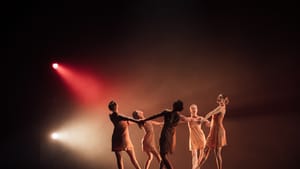Stay in the Loop
BSR publishes on a weekly schedule, with an email newsletter every Wednesday and Thursday morning. There’s no paywall, and subscribing is always free.
Back to the source
Koresh Dance Company presents ‘La Danse’

Henri Matisse’s La Danse, painted in flattened masses of deep primary colors, is often described as ominous or paganistic. The green rising from the bottom of the painting might be a hill; the blue could be sky, or a lake. At the center, crushing the hill under their feet, dance a circle of five nudes that Matisse painted deep red, outlined in brown like a Paleolithic cave painting. Now it’s the inspiration for the latest from Koresh Dance Company.
In his comments before the performance, Roni Koresh explained that he had grown up with a print of La Danse in his home, so he knew it intimately. Later, he came upon Le Bonheur de Vivre, a garden scene where Matisse’s circle of nude dancers first appear, small and pale in the background, like an idea waiting to happen. Koresh’s dance drew inspiration from the contrasts between the sunlit verdure of Le Bonheur and the intense dynamism of La Danse itself.
Shouldn’t work—but it does
When I think about it analytically, Koresh’s La Danse shouldn’t work at all, and yet it did. The piece gave us 16 separate named dances. Each dance had not one set tempo but two or three, sometimes shifting from one to another within the same step combination. “Put on Your Red” featured Micah Geyer in black and Callie Hocter in a calf-length red slip dress, performing a sexy tango mixed with fox trot.
In the section titled “Sisters in the Trees,” Melissa Rector, Paige Devitt, and Callie Hocter danced to country-Western fiddle and jazz trombone, their steps blending social dance styles with leg extensions that show off their technique. Then, in a circle that marked a recurring motif, they clasped hands and leaped in skips and hops that echoed Isadora Duncan while Peter Jakubowski’s green and blue lighting reminded us of the garden in Matisse’s Bonheur.
A light touch
I generally don’t call much attention to lighting, because I often don’t like it. I’m annoyed by the concept that a dark stage equals atmosphere, and I really hate mist. So I appreciate Jakubowski’s lighting design for using these techniques to actually enhance each dance. Besides the garden’s blues and greens, the crosshatched gold and brown that filled the stage for “Without Thought” may have been the best thing about that dance, and set the mood for the more interesting “Red Hand of Love” that followed it.
Composer John Levis’s commissioned score gave La Danse the aural cohesion it needed. I would have taken it home for my playlist. In discussion after the program, Levis amazed us all when he explained that he had created the sound of all the instruments electronically.

“Let’s dance”
Karl Mullen’s recorded voiceovers, fragments of his poem commissioned for this work, led us ominously through the performance. “The center did not hold,” he said, in a recurrent refrain that references William Butler Yeats’s apocalyptic “The Second Coming,” and “Solid air has come undone.” As an antidote, Mullen’s poetry and Koresh’s dancers exhorted us to hold back the dark: “Let’s dance,” they said, in words and movement.
The poem reflects the moods of La Danse, shifting from the aggressive, muscularly angular dancing of the company in red and black to the more intimate pieces. “Hold My Breath,” with Melissa Rector, in a white dress that floated like a nightgown, and Devon Larcher, in grey and white (Koresh designed the costumes, with the help of Cari Shappell), were light as air in a romantic sequence of low lifts held close as an embrace that takes a darker turn.
But the performance’s theme, teased out in the bits of Israeli folk dance to drum and flute, came down to the idea repeated in the poem: “My American dream.” Koresh was born in Israel. The piece is a political statement—how could it not be, when the drumbeat of Mullen’s words “The center did not hold” drives the message and the poem says he is “hanging by a thread”?
But Koresh’s style gives us hope as he spins us from rhythm to rhythm; from jazz to bop to country-Western. He embraces the well-known steps of each popular dance form and wraps them in contemporary technique to show us a vision of his American dream: an America made richer by embracing its differences. That dream is under threat, but Koresh offers dance to heal the rift—go back to the source, he said, in answer to a question from the audience. He was talking about the Israeli dancing and the drums and flutes of his Mediterranean background, but you can also understand that as dance itself, in all its variety. The body in motion tells our story.
What, When, Where
La Danse. Choreography by Ronen Koresh. Koresh Dance Company. April 25-28, 2019, at the Suzanne Roberts Theatre, 480 S. Broad Street, Philadelphia. (215) 985-0420 or koreshdance.org.
The Suzanne Roberts Theatre is an ADA-compliant venue with wheelchair seating in both the orchestra and mezzanine. Patrons with questions about accessible seating can call (215) 985-0420 or email [email protected].
Sign up for our newsletter
All of the week's new articles, all in one place. Sign up for the free weekly BSR newsletters, and don't miss a conversation.
 Camille Bacon-Smith
Camille Bacon-Smith